Top 10 baits from Clear Lake
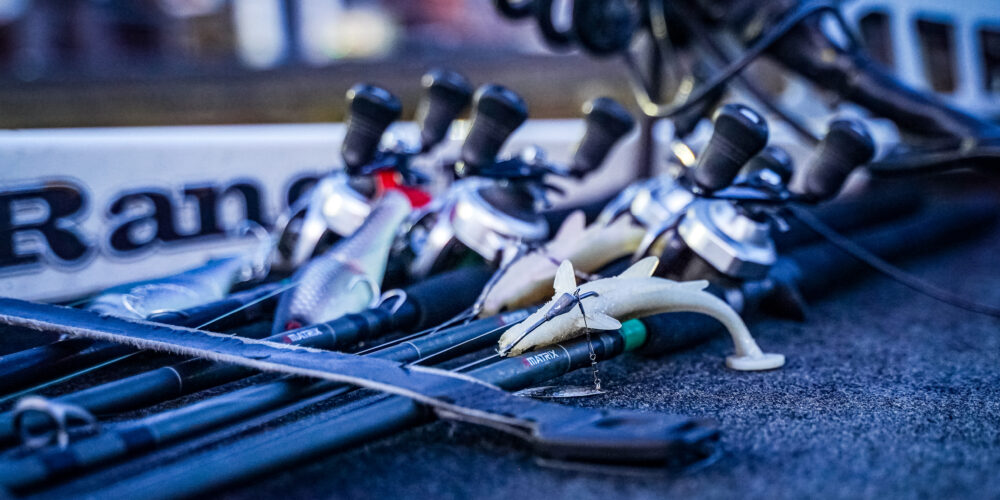
LAKEPORT, Calif. – With the Western Division Presented by Tackle Warehouse opener fast approaching, Clear Lake got blasted by freezing temperatures and snow, just as the fishery’s healthy population of trophy-class bass were in the incipient stages of moving up shallow to spawn. As a result, practice was overwhelmingly difficult for many anglers in the 80-boat field, and each day of the three-day Toyota Series Presented by Phoenix Boats event presented new challenges as weather warmed and stabilized and those big bass began to move to the shallows en masse.
And though tournament weights weren’t quite as hardy as was expected days prior to that snowstorm, it still took 82-6 over three days for Ken Mah to take home his first MLF victory in his 18th season fishing Western Division tournaments. Mah, who’s found immense success everywhere he’s fished out West in his career, went off the beaten path to catch his winning fish flipping up shallow with a jig and a creature bait.
The rest of the Top 10 was a mixed bag in terms of techniques and approaches. Most relied on forward-facing sonar to find their fish each day (as massive schools were constantly moving around from prespawn staging area to prespawn staging area), though the technology that’s taken bass fishing tournaments by storm didn’t necessary play a major role in actually catching those fish for many of the event’s best.
A lot was in play throughout the tournament – the only common theme being that everyone had to stay on their toes and follow the bass migration all three days.
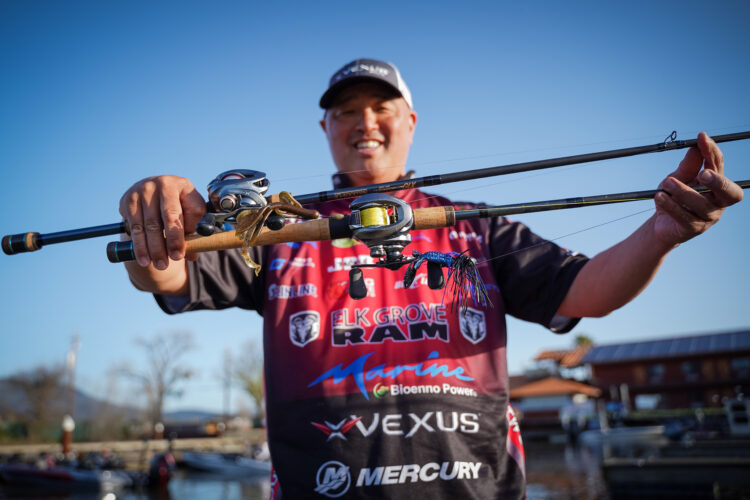
1. Mah flips up first MLF win
To start the tournament, most anglers spent their time offshore in prespawn staging areas – many of which included ample cover thanks to Clear Lake’s resurgent water levels of late. After a period of low water that allowed vegetation to grow in areas now 10 or so feet deep, those willow bushes and other forms of undergrowth are hanging out in prime prespawn areas that happened to be packed with bass.
Still, as the tournament went on and those fish moved shallower, everyone had to adjust. Mah did it better than anyone else.
“I (caught) my biggest one near the bank,” he said. “That was late in the day on Day 1. And that kind of clued me in a little bit. As the tournament went on, I started to catch less and less of them out of the brush and more and more on the bank. That was a key move for me.
“I followed those big fish. They want to move shallow right now. … Being able to follow them shallow was a key adjustment.”
For the task of shallow flipping along the bank, Mah relied on a black-and-blue jig with a 3-inch Big Bite Baits YoMama trailer tied to 65-pound-test braid spooled on a Shimano Chronarch 150 MGL reel paired with a G. Loomis GLX 894 rod. He also flipped just the YoMama on 22-pound-test Sunline Shooter with the Chronarch and a G. Loomis GLX JWR895.
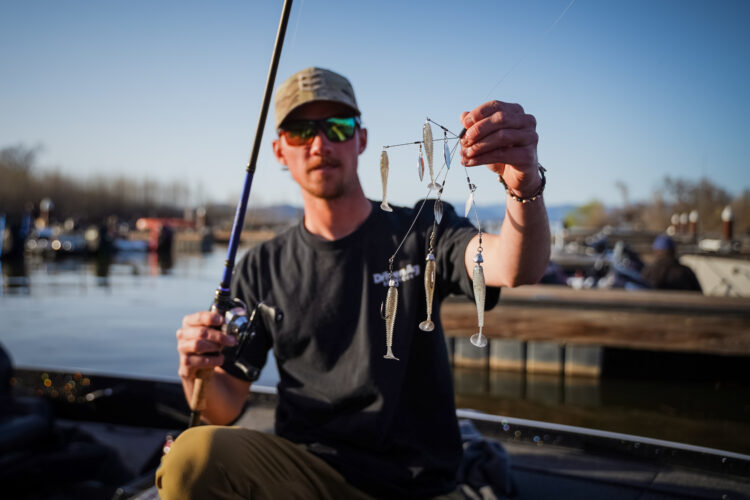
2. Mariani leans on the umbrella rig
Plenty of anglers tried to make an umbrella rig work for them at Clear Lake, but Joe Mariani was by far the most successful. He caught 14 of the 15 keepers he weighed in on a G Funk Alabama rig armed with 1/4-ounce Strike King swimbait heads and 2.8- and 3.3-inch Keitech Swing Impact FATs (rainbow shad).
The size of the Keitechs, it seems, was the key to his second-place finish.
“I had been throwing a bigger-sized A-rig and I wasn’t getting bit as much,” he explained. “I downsized to 3.3 and 2.8 Keitechs, and that was the deal.”
For his umbrella rig setup, Mariani spooled up a Shimano Tranx 201 with 20-pound-test Seaguar InvizX fluorocarbon and paired it with a Powell Endurance 905 rod. The only keeper he didn’t catch on an A-rig (a 5-pounder on Day 1) was caught on a Lucky Craft jerkbait.
Like most everyone else, Mariani used forward-facing sonar to locate his fish and study their moods, though he didn’t actively watch any fish eat his bait.
As for the areas he fished during the tournament, that all came down to familiarity and comfort.
“I live an hour away from [Clear Lake],” he said. “I fish team tournaments there all the time. We know the lake pretty well.
“It was such a tough practice, and I really like fishing that Rattlesnake Arm, the rocks down there and all that, so I just stuck to the best area I know on that lake – every little rock pile and point that popped up.”
Water depth also seemed to be key for Mariani.
“It seemed like if I had my boat sitting in that 8-to-12-foot range, that was the perfect number,” he said. “If I was any deeper, they got fewer and farther between. Those weren’t the active fish out there.”
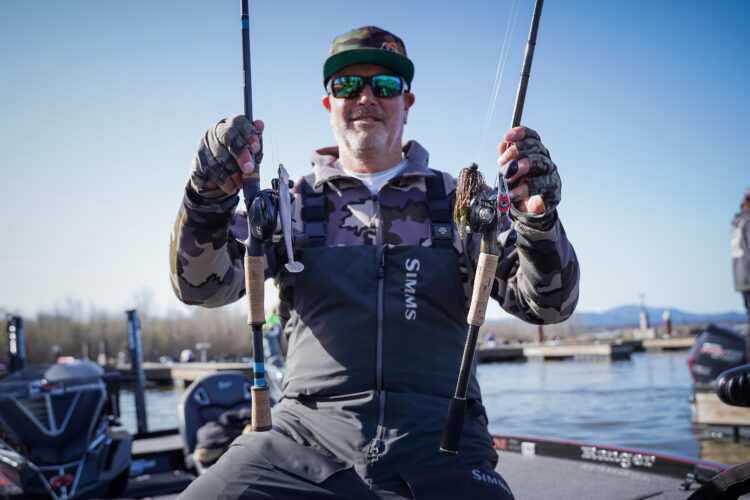
3. Strelic runs rotation of rock
While Jon Strelic found and caught a lot of fish in practice on a 1/2-ounce football jig with a green pumpkin Reaction Innovations Sweet Beaver 4.20 trailer, that jig didn’t do much damage during the tournament proper. Still, Strelic credits the bait for helping him get on his 74-1 worth of bass during the event.
To catch most of his fish, Strelic turned to a 4.8-inch Gan Craft Bariki Shad (pro blue) on a Megabass Body Balance swimbait head. He tied that to 14-pound-test Sunline Sniper fluorocarbon spooled on a Daiwa Steez A (7.1:1 gear ratio) paired with a G. Loomis NRX+ 854.
Strelic also caught several of his biggest keepers on that same Bariki Shad but on a Coolbaits The Down Under 3/8-ounce underspin head with a silver blade, which he swapped out from the stock gold blade. For that presentation, he went with 12-pound-test Sniper, a Steez A and a G. Loomis NRX+ 893.
To catch his fish, Strelic made a milk run of eight or nine rock piles in prespawn staging areas. He had a rotation he ran each day on those piles, using Garmin LiveScope to find his targets and make semi-blind casts to them. (Between the fish sitting close to the rocks and the wind and waves rocking his boat, Strelic said he couldn’t see any fish actively biting his baits.)
That worked fairly well on Day 1 (to the tune of 24 pounds) and even on Day 2 as he weighed in a massive 27-5 limit, though he only got six bites in total. On the final day of competition, Strelic’s fish moved on him.
“I did my best to follow them,” he said. “I think I could have done a better job.
“I could feel the bass kind of getting behind me. I just had that feeling. I wasn’t seeing them on the ‘Scope as well in the areas I had been catching them. In the afternoon I moved up shallower and I just started probing around shallow with a swimbait and ended up catching one of the key fish I caught on Day 3, which was like a 6 1/2-pounder.”
More than anything else, though, Strelic credits his roommates for his third-place finish.
“I was rooming with Mike Walsh (sixth-place Strike King co-angler) and Julius Mazy (34th-place boater), and those guys were so helpful,” he explained. “I would get back and grab all my tackle and throw it on the bench and they went to work. Mike was sharpening hooks, me and Julius re-tied the rods and Mike would pre-rig swimbaits for me so every day I went out I had 10 pre-rigged swimbaits done … I was so appreciative of those guys helping me out.”
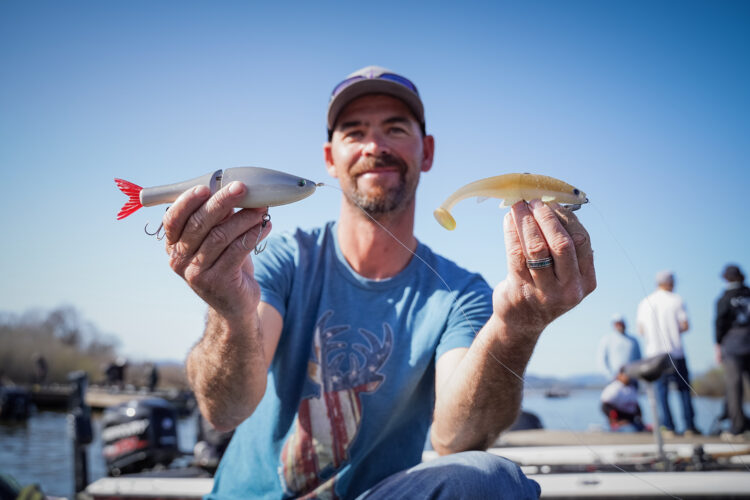
4. G-Ratt to the rescue for Pearl
John Pearl led after Day 1 on the strength of a 29-pound, 1-ounce bag he caught mostly on a 6-inch G-Ratt Executioner swimbait (lite trout), which he helped design with Gary Collins. For that 1-ounce bait, Pearl went with 20-pound-test Seaguar Tatsu spooled on a Shimano Tranx 201 paired with an 805D Douglas XMatrix rod. He also did some work with a G-Ratt Sneaky Pete glide bait.
Pearl spent his time in staging areas outside creek mouths. A full-time guide on Clear Lake, he had a sense that the bass were itching to move up into the creeks and managed to land on several good fish in those areas. Unfortunately, a 20-14 bag on Day 2 put Pearl a little too far behind to catch up, even with a 23-14 finish.
In those staging areas, Pearl primarily targeted fish relating to submerged willows in about 12 feet of water. On Day 1, despite weighing in nearly 30 pounds, Pearl missed about 15 bites on the swimbait – “live by the sword, die by the sword,” he said.
Still, his swashbuckling approach was good for a fourth-place finish and a $6,565 payday.
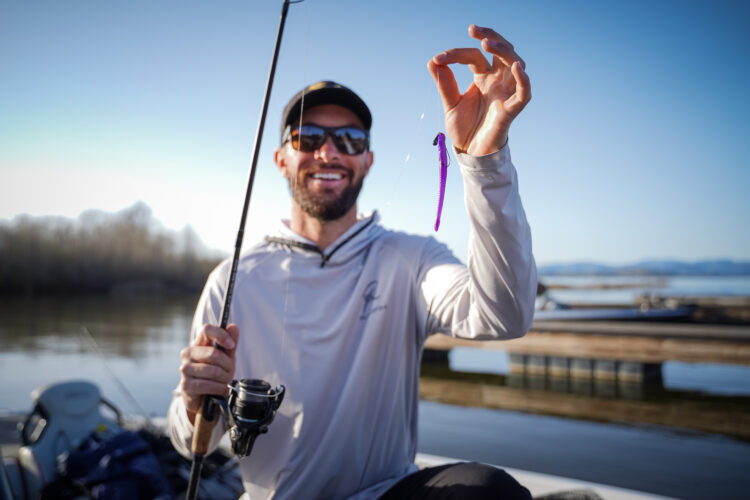
5. Melton rides the superhighway
Christian Melton found the kind of area every bass angler dreams of when he took up residence outside the bays around Kelsey Creek. There, he used forward-facing sonar to identify masses of bass cruising toward the shallows to eventually start spawning.
“They were using the new brush line as a highway to flood into the bay they wanted to spawn in,” he said. “I was fishing the mouths of a few bays on the south shore by the Kelsey Creek area. Those transitional cutouts in the brush were where they would stage up.
“The mouth was my best area. I would see them on my [forward-facing sonar] coming in by the hundreds. I would try to pick off as many as I could and got 10 to 20 to 30 bites a day.”
As the tournament progressed, more and more fish got into the backs of the pockets. Those fish, Melton said, got super active, and he was able to rotate through those areas to pick off new fish as they moved up.
For the task, Melton used “one bait and one bait only”: a Roboworm Straight Tail (4.5- and 6-inch) in M.M. III and Margarita Mutilator colors. He free-rigged it with a 1/8-ounce tungsten weight and a 1/0 or 2/0 Owner Cover Shot hook (depending on which size worm he was using). He tied those baits to a 10-pound-test Seaguar Red Label fluorocarbon leader attached to 15-pound-test Seaguar Smackdown braid.
For his rods, Melton went with the Dobyns Champion XP 703 model. He paired those with various Shimano reels, including a NASCI and a Vanford.
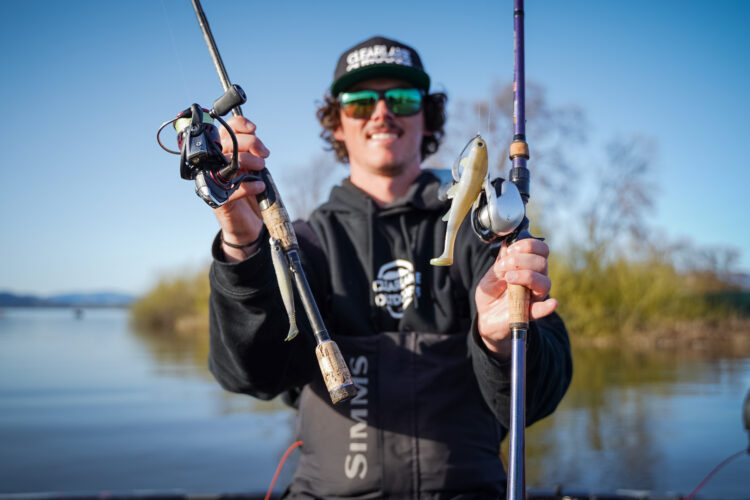
6. Phillips keeps it simple
Like many other anglers in the field, Nathan Phillips spent his time in staging areas outside the mouths of various creeks, his being in the northern portion of the lake. He primarily looked for areas with submerged willows that bass were using for cover as they transitioned shallower ahead of the spawn.
“The thing that was making the difference was having some sort of [cover],” he said. “When the lake got really low, a lot of willows grew. The submerged willows were really what I was targeting. On a couple spots there was some other stuff mixed in, like some dead primrose. Those dead roots at the bottom were enough for some of those fish to hold on to as well.”
Using Garmin LiveScope, Phillips employed a pair of G-Ratt swimbaits to catch his fish, most of which came on the spinning rod and smaller 4-inch offering. For that setup, he went with a G-Ratt Thin Swim (pro blue) tied to 10-pound-test Seaguar Tatsu on a 20-pound-test Seaguar Smackdown main line. The reel was a Daiwa Ballistic and the rod a Dobyns Champion 702.
In addition to the smaller offering, Phillips also wielded a G-Ratt Executioner (Tennessee Shad and Lite Trout) on 20-pound-test Tatsu, an 8-foot, medium-heavy Phenix M1 rod and a Shimano Tranx 201 reel.

7. No ‘Scope for Jackson
Juarez Jackson caught 25-4 on Day 3 – by far his biggest bag of the event – with his electronics turned off. This, he believes, was part of the reason for his success. After identifying masses of bass in his area on Days 2 and 3, he found those fish more apt to bite with the graphs and transducers off.
On Day 1, during which Jackson only caught seven fish, he spent his time on rock piles in staging areas around the mouths of creeks. But on Day 2, with fish moving up, he pushed shallower and went to work with a variety of baits.
To catch his early limits, Jackson went with a Z-Man/Evergreen ChatterBait Jack Hammer (green pumpkin) with a 4.8-inch green pumpkin Keitech Swing Impact FAT trailer. He threw that setup on a 7-foot, 11-inch Powell Max and a Shimano Curado 200K spooled with 20-pound-test Sunline Sniper.
While the ChatterBait did the numbers, a couple big swimbaits did the heavy lifting: a G-Ratt Executioner and a Jaw Jack’n Baits trout. For both swimbaits, Jackson wielded Dobyns Champion XP rods, Shimano Tranx 200 reels and 25-pound-test Sunline Sniper.
Jackson credits his mix of baits for keeping fish on their toes on the final two days – especially because the ChatterBait was barely represented in the rest of the Top 10.
“It was pretty cool,” he said. “Nobody was really throwing a ChatterBait, and on the second and third days I had to use pliers (to get the hook out). They were choking it. At one point I went four for four (four fish in four casts).”
Jackson also raved about the Jaw Jack’n swimbait and Executioner, both of which he said are “killing the game” at Clear Lake right now.
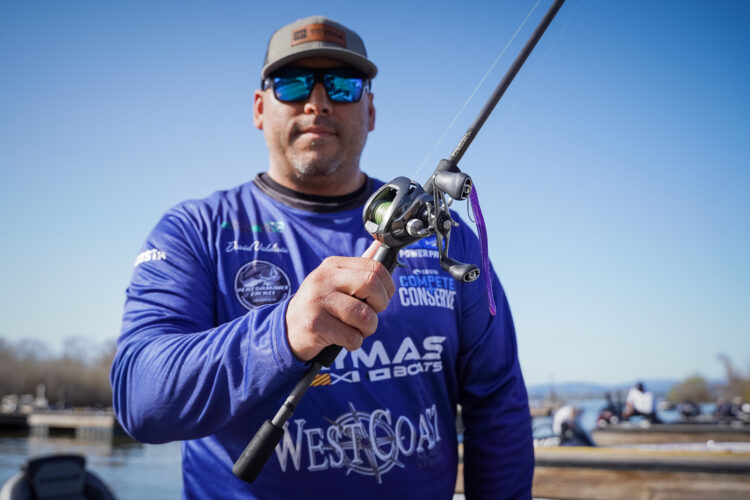
8. Drop-shot and a Roboworm for Valdivia
Peanut butter and jelly. Peas and carrots. Clear Lake and a Roboworm.
David Valdivia knows what works at Clear. For his one and only setup for the week, he leaned heavily on a drop-shot rig tipped with a Roboworm. What’s interesting, though, is how he chose to apply that presentation.
In the style of a power-shot rig, Valdivia threw his drop-shot on a casting setup consisting of an 8.1:1 Shimano Metanium reel, a medium-power Performance Tackle custom rod and 12-pound-test fluorocarbon connected to a 30-pound-test Daiwa J-Braid main line. The weight was only a 1/8-ounce tungsten sinker, though.
“The beauty with the Metanium is that it’s kind of an all-around reel because of the brake system in it,” Valdivia explained. “You can cast a 1/8-ounce drop-shot on it, and then turn around and tie on a 6- or 7-inch swimbait and use it for that.”
Because Valdivia knew he was around fish he identified in practice – despite a “brutal” practice in which he struggled to get bit – he chose to force-feed the drop-shot until it started doing numbers. By Day 3, he managed roughly 20 keeper-sized fish.
Valdivia’s area in the midlake portion of Clear was a staging spot that coincided with the lake’s old weed line prior to lake levels rising. There, he found old, submerged tules that held some quality fish.
“I knew they were in that zone in practice,” he said. “I never got a bite, but I knew those were bass. When I rolled back up in the tournament, I just threw the worm in there. It was pretty crazy. Once I got bit, it was the only thing I got bit on. I didn’t want to switch.”
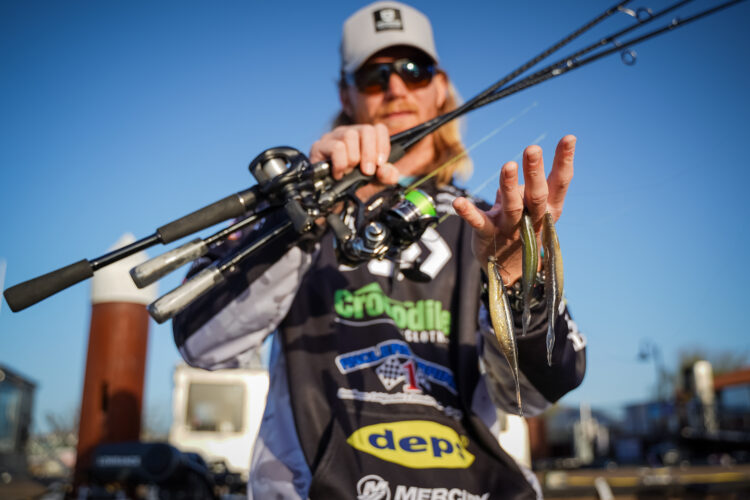
9. Shallow finesse and ‘Scoping for Blackamore
JD Blackamore found an area of Clear Lake loaded with bass that weren’t as hard to track as in some other areas of the lake. His fish, he said, weren’t pushing up as shallow, instead moving around each day in the same general spot.
“In my area they weren’t moving up shallower; they were just moving down the bank further into a creek,” Blackamore explained. “They’d move like 100 feet every day it seemed like.
“They were just tougher to get to bite. I’d find them every day, find the big ones, see them on my forward-facing sonar, but it just got tougher each day. I don’t know if it was the pressure or the weather or a little of both.”
The numbers seemed to back up Blackamore’s assessment. After catching 26 pounds on Day 1, he managed 22-15 on Day 2 and just 16-1 on the final day.
To catch his fish, Blackamore set up a couple strolling and weightless rigs to use in unison with his Lowrance ActiveTarget 2, both featuring a Deps Sakamata Shad (5- and 6-inch) in a natural, green pumpkin color.
For the strolling rig, Blackamore used various weights of Ryugi Vespa tungsten ball heads and switched to a weightless rig with an EWG hook when he wanted the bait to “get up in the sticks.”
For the strolling setup, he employed a 7-foot, 1-inch, medium-light Daiwa Tatula XT rod and a Daiwa Tatula MQ LT spinning reel spooled with 10-pound-test Daiwa J-Braid and a 7-pound-test Daiwa J-Fluoro Samurai leader. For the weightless applications, Blackamore went with a 7-foot, 3-inch medium-heavy Tatula XT and a Daiwa Tatula 100 reel with 16-pound-test J-Fluoro Samurai.
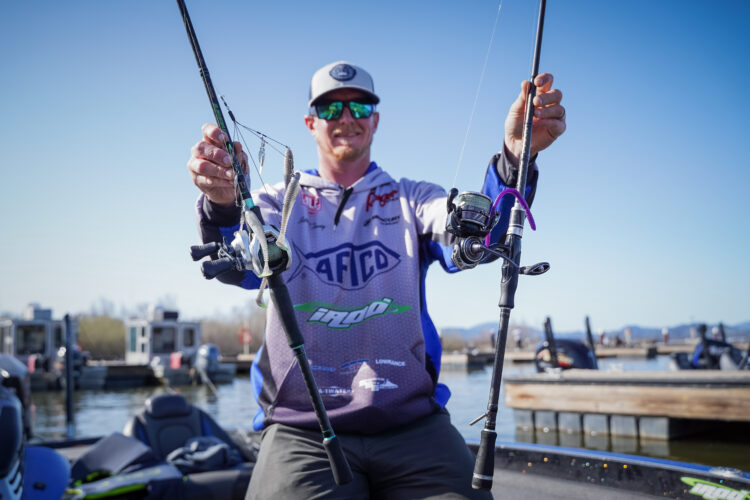
10. Touey makes the right adjustments
Patrick Touey started the event slinging A-rigs (a G Funk Cali Rig and a larger, stouter Garagetek umbrella rig), but his bite was fading fast over the first two days. After securing a bag of nothing but 4-pounders on Day 1 and weighing in 17-14 on Day 2, Touey caught a limit around 16 pounds on the morning of Day 3 on the A-rig, then went to the other extreme and moved up shallower with a drop-shot in hand.
“I went down to my primary area and had some fish follow the A-rig and not get it, so I knew I needed to put it down,” he said. “I tied up a purple worm and started ‘Scoping, and the first two fish were a 5.70 and another right at 5. I grinded the rest of the day out with the worm and added another nice one that got me to 23-11 on the final day.”
That worm was a 7-inch Margarita Mutilator Roboworm Straight Tail, wacky-rigged on a 1/0 Gamakatsu Split Shot hook with a 3/8-ounce drop-shot weight. He rigged that on an iRod Air (722 model) and a 3000-size Daiwa Tatula reel spooled with 12-pound-test fluorocarbon.
For the umbrella rigs, Touey went with an iRod Genesis III 764 rod paired with a Shimano Tranx 200. For the G Funk Cali Rig, Touey opted for 25-pound-test Seaguar InvizX and 65-pound-test braid for his stouter rig. Both were tipped with 1/4-ounce heads and 3.8-inch Keitech Swing Impact FATs (pro blue shiner), with the tails of the hooked baits dipped chartreuse.